国际市场营销复习资料 (中英文)
- 格式:doc
- 大小:66.50 KB
- 文档页数:7
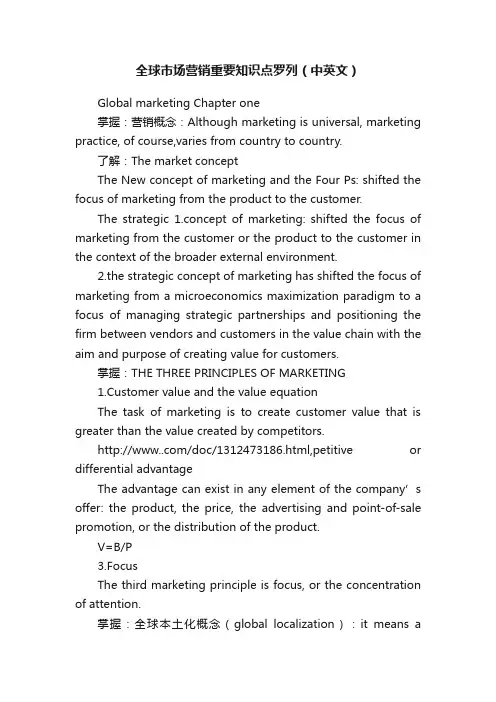
全球市场营销重要知识点罗列(中英文)Global marketing Chapter one掌握:营销概念:Although marketing is universal, marketing practice, of course,varies from country to country.了解:The market conceptThe New concept of marketing and the Four Ps: shifted the focus of marketing from the product to the customer.The strategic 1.concept of marketing: shifted the focus of marketing from the customer or the product to the customer in the context of the broader external environment.2.the strategic concept of marketing has shifted the focus of marketing from a microeconomics maximization paradigm to a focus of managing strategic partnerships and positioning the firm between vendors and customers in the value chain with the aim and purpose of creating value for customers.掌握:THE THREE PRINCIPLES OF MARKETING1.Customer value and the value equationThe task of marketing is to create customer value that is greater than the value created by competitors./doc/1312473186.html,petitive or differential advantageThe advantage can exist in any element of the company’s offer: the product, the price, the advertising and point-of-sale promotion, or the distribution of the product.V=B/P3.FocusThe third marketing principle is focus, or the concentration of attention.掌握:全球本土化概念(global localization):it means asuccessful global marketer must have the ability to “think globally and act locally”掌握:MANAGEMENT ORIENTATION1.Ethnocentric (母国中心)---------international companyHome country is superior, sees similarities in foreign countries2.Polycentric(东道国中心)-----------multinational companyEach host country is unique sees differences in foreign countries3.Regiocentric(区域中心)----------global companySees similarities and differences in the world region; is ethnocentric or polycentric the rest of the world.4.Geocentric (世界中心)-------------transnational companyWorldview, sees similarities and differences in home and host countries.了解:Leverage定义:Leverage is simply some type of advantage that a company enjoys by virtue of the fact that it conducts business in more than one country.类型:1.experience transfers(经验移植) 2.Scale economies (规模经济:可降低成本)3.resource utilization (资源利用)4.global strategy(全球化战略)Chapter two了解ECONOMIC SYSTEMS1.Market allocationA market allocation system is one that relies on consumers to allocate resources.Consumers“write” the economic plan by deciding what will be produced by whom./doc/1312473186.html,mand or centralplan allocationIn a command allocation system, the state has broad powers to serve the public interest.These include deciding which products to make and how to make them.3. Mixed allocation了解STAGES OF MARKET DEVELOMENTUsing GNP as a base , we have divided global markets into four categories.1.low-income countries(also known as preindustrial countries)2.lower-middle-income countries(also known as less developed countries or LDCs)3.upper-middle-income countries(also known as industrializing countries)4.high-income countries(also known as advanced , industrialized, postindustrial countries) chapter three 了解:BASIC ASPERTS OF SOCIETY AND CULTURE①It is learned, not innate②The various facts of culture are interrelated, influence or change one aspect of a culture and everything else is affected.③It is shared by members of groups and defines the boundaries between different groups.掌握:High and low context cultures强交际环境文化和弱交际环境文化的对比(看73页表) In low context cultures,①messages have to be explicit.②A person's word is not t o be relied on.③Paperwork is important.In high context cultures,①less information is contained in the verbal part of message.② A person's value, position, background are crucial.掌握:Maslow's Hierarchy of Needs 马斯洛需求层次理论①physiological 生理需求②safety 安全需求③social 社交需求④esteem 尊重⑤self-actualization 自我实现掌握:Hofstede Framework 霍夫斯诺德构架(看细节)①individualism versus collectivism 个人主义与集体主义②power distance 权力距离③uncertainty avoidance 不确定性规避⑤masculinity versus femininity 男权主义相对女权主义了解:THE SELF-REFERENCE CRITERION AND PERCEPTION As we have shown, a person’s perception of market needs is framed by his or her own cultural experience.了解:ENVIRONMENTAL SENSITIVITY(了解80页表格)Environmental sensitivity is the extent to which products must be adapted to the culture-specific needs of different national markets. (对环境中最敏感的东西是food)Chapter four了解POLITICAL RISK (经济发达阶段和政治风险的关系,经济越不发达政治风险越高)了解征用(EXPROPRIATION)定义:Expropriation refers to governmental action to dispossess a company or investor.没收(CONPENSATION)定义:compensation is generally provided to foreign investors,although not often in the “prompt effective ,and adequate”manner provided for by international standard.国有化(NATIONALIZATION)定义:Nationalization occurs ifownership of the property or assets in question is transferred to the host government.了解:Differences of the two systems in solving commercial disputes两种法律体系在解决商务纠纷中的区别common law versus civil law(code law)①Under common law, commercial disputes are subjected to either civil or commercial laws. Under code law, commercial disputes are subjected to the commercial code.②Under common law, industrial property right based on proof of agreement.Under code law, industrial property right based on notarization or registration③Under common law, Performance of contract: Act of God/act of nature means extraordinary happenings not reasonably anticipated.Under code law, Performance of contract: Act of God is extended to include unavoidable interferences such as strike or riots (Force Majeure)掌握:Three bases for jurisdiction in resolving private international disputes处理国际争端的3种基本司法程序①negotiation调解协商②Arbitration仲裁③Litigation 诉讼Chapter five掌握:DIFFUSION THEORY(传播理论)(AIETA)Five stages of the adoption process 对新产品接纳过程的五个阶段①Awareness 知晓阶段②Interest 感兴趣阶段③Evaluation 评价阶段④Trial 试用阶段⑤Adoption 采纳阶段Five types of adopter categories 新产品接纳者的5种类型②innovators②early adopters(Early adopters are the most influential people in their communities,even more than the innovators. Thus. The early adopters are a critical group in the adoption process )③early majority④late majority⑤laggards (落后者)掌握:Characteristics of innovations(创新的特征)1.Relative advantage(相对优势)/doc/1312473186.html,patibility(兼容性)/doc/1312473186.html,plexity(复杂性)4.Divisibility(可分性)/doc/1312473186.html,municability(可交流性)Chapter six了解Information subject agenda (理解168页表格)了解SCANNING MODES(搜寻模式): SURVEILLANCE AND SEARCH监视的两种类型Surveillance include: viewing and monitoring 了解营销信息的主要来源(sources of market information):1.human sources (人)2.documentary sources(文档资源)3.internet sources(因特网来源)4. Direct perception(直接感知)了解FORMAL MARKETING RESEARCH(正式的市场调研)Step 1: Identifying the research problemStep 2: Developing a research planStep 3: Collecting data (看细节secondary data, primary data, survey research)Step 4: Analyzing research dataStep 5: Presenting the findingsChapter seven掌握市场细分的定义: Market segmentation is the process of subdividing a market into distinct subsets of customers that behave in the same way or have similar needs.掌握全球市场细分的定义:Global market segmentation is the process of dividing the world market into distinct subsets of customers that behave in the same way or have similar needs.掌握全球市场的主要细分的标准(criteria)(知道归属):1.Geographic segmentation2.Demographic segmentation3.Psychographic segmentation4.Behavior segmentation5.Benefit segmentation掌握全球目标市场确定的定义:T argeting is the act of evaluating and comparing the identified groups and then selecting one or more of them as the prospect(s) with the highest potential.掌握选择目标市场的标准(criteria):1.current segment size and growth potential2.potential competition/doc/1312473186.html,patibility and feasibility掌握选择目标市场的策略:1.standardized global marketing2.concentrated global marketing3.differentiated global marketing掌握全球产品定位(Global product positioning)定义:Positioning is the location of your product in the mind of your customer.Chapter eight掌握出口市场选择的六大标准(MARKET SELECTION CRITERIA):1.market potential(市场潜量)2.market access (市场潜入因素)3.shipping costs(运输成本及时间)4.potential competition(潜在竞争)5.service requirement(服务要求)6.product fit(产品适应性)了解ENTRY AND EXPANSION DECISION MODEL(进入和扩张决策模型,第237页)掌握依托营销(Piggyback Marketing)的定义:The manufacturer using the piggyback arrangement does so at a cost that is much lower than that required for any direct arrangement. Successful piggyback marketing requires that the combined product lines be complement. They must appeal to the same customers, and they must not be competitive with each other.掌握许可贸易(licensing)的定义:Licensing can be defined as a contractual arrangement whereby one company(the licensee) makes an asset available to another company(the licensing) in exchange for royalties, license fees, or some other form of compensation. The licensed asset may be a patent, trade secret, or company name.其中,Franchising is a form of licensing了解Joint Ventures(第247页)了解市场扩张战略(5 MARKET EXPANSION STRATEGIES):1.Strategy one: concentrates on a few segments in a few countries.2.Strategy two: country concentration and segment diversification3.Strategy three: country diversification and market segment concentration4.Strategy four: country and segment diversificationChapter nine了解全球战略联盟的三个特点:1.The participants remain independent subsequent to the formation of the alliance2.The participants share the benefits of the alliance as well as control over the performance ofassigned tasks.3.The participants make ongoing contributions in technology, products, and other key strategicareas.了解全球战略同盟的六个特性(attributes)(第265页)在日本,战略联盟被称为综合商社在韩国,战略联盟被称为财阀Chapter ten掌握影响产业竞争的五种力量(Forces Influencing Competition in a Industry):1.Thread of new entrants2.Rivalry Among Existing Competitors3.Bargaining Power of Suppliers4.Bargaining Power of Buyers5.thread of Substitute Product or Services掌握新加入者的五种威胁(thread of new entrants):1.Economies of scales(规模经济)2.Product differentiation(产品差异性)3.Capital requirements(资本要求)4.Switching costs(转换成本)5.Access to distribution channels(获取分销渠道的途径)/doc/1312473186.html,ernment policy(政府政策)7.Established firms may also enjoy cost advantages independent of the scale economies(老公司享有的与规模经济无关的成本优势)掌握Porter’s basic thesis(Porter’s diamond): four national attributes of a nation shape the environment in which local firms compete.波特钻石理论中认为决定一国本地公司竞争环境的四大特征:①factor condit ions②demand conditions③related and supporting industries④firm strategy, structure, rivalryAnd two influencers: Governments and chance其中,了解要素来源(factor conditions)的分类1.Human resources2.Physical resources3.Knowledge resources4.Capital resources5.Infrastructure resources掌握要素资源的类型1.Basic versus advanced factors(基本要素与高级要素)2.Generalized(通用要素是前提条件)versus specialized factors(专门要素是企业真正竞争要素的来源)掌握创造竞争优势的一般战略:1.Broad market strategy 大市场战略Cost-Leadership Advantage(成本领先)Differentiation(差异化)2.Narrow target strategies(缩小目标范围)Focused differentiation (差异专注)Cost focus(成本专注)了解日本人创新性竞争的策略:/doc/1312473186.html,yers of advantage (优势层)2.Loose bricks(松动的砖头)3.Changing the rules(改变规则)4.Collaborating(合作)5.Hypercompetition (超级竞争)CHAPTER11了解产品含义(了解产品属于哪类)Local products(本土产品):A local product is available in a portion of a national market. National products(国家产品): A national product is one that, in the context o a particular company is offered in a single national market.International products(国际产品): international products are offered in multinational,regional markets.Global products(全球产品):global products are offered in global markets了解产品与品牌的不同(了解334页的全球品牌的特征--------地球图)A global product differs from a global brand in one important respect: it does not carry the same name and image from country to country.掌握产品定位(product positioning)的定义:product positioning is a communications strategy based on the notion of mental "space": positioning refers to the act of locating a brandin customers' minds over and against other products in terms of product attributes and benefits that the brand does and does not offer.掌握产品定位的一般策略(general strategies for positioning products)1.attribute or benefit (属性与性能)2.Quality/price(质量价格)/doc/1312473186.html,e/user (使用和使用者)4.High-tech positioning (高科技定位)5.High-touch positioning (高感性定位)掌握产品设计的四个因素(Product design considerations)Global market need to consider four factors when making product design decision:1. Preferences (偏好)2. Cost (成本)3. Laws and regulations(法律法规)4. Compatibility(兼容性)5. Labeling and instructions (标签以及用法说明)了解原产国的态度的(coo:country of origin)定义:Country of origin (often abbreviated to COO), is the country of manufacture, production, or growth where an article or product comes from. There are differing rules of origin under various national laws and international treaties掌握产品地理扩张的主要策略(5个)Strategy1:product/communication extension(dual extension) Strategy2:product extension/communication adaptationStrategy3:product adaptation/communication extensionStrategy4:dual adaptationStrategy5:product invention理解公司的三个阶段(How to choose a strategy)1.cave dweller.(洞穴居住着)2.Naive nationalist(天真的国家主义者)3.Globally sensitive(全球性敏感者)了解新产品开发的几层含义(New products in global marketing):Newness can be assessed in t h e c o n t e x t o f t h e p r o d u c t i t s e l f,t h e o r g a n i z at i o n,a n d t h e m a r ke t.1.an entirely new invention or innovation2. a line extension3.newness may also be organizational4.an existing product that is new to a company may be new to a particular market了解新产品开发的几个步骤:1.Identifying new-product ideas2.New-product development location3.Testing new products in national marketsCHAPTER 12掌握环境对定价决策的影响(Environmental influences on pricing decisions)1.Currency fluctuations(货币的不稳定性)2.Exchange rate clauses(汇率条款)3.Pricing in an inflationary environment(在通货膨胀的环境里定价)/doc/1312473186.html,ernment controls and subsidies(政府控制和补贴)/doc/1312473186.html,petitive behavior (竞争行为)6.Price and quality relationships(价格与质量的关系)掌握全球定价目标及战略(Global pricing objectives andstrategies)1. 掌握市场撇脂(Market skimming)定义:the market skimming pricing strategy is a deliberate attempt to reach a market segment that is willing to pay a premium price for a product.2. 掌握渗透式定价(Penetration pricing)定义:penetration pricing uses price as a competitive weapon to gain market position.3. 掌握市场保持(Market holding)定义:the market holding strategy is frequently adopted by companies that want to maintain their share of the market.4. 掌握成本加成价格升级Cost plus/price escalation掌握价格升级的定义:Price escalation is the increase in a product’s price as tr ansportation, duty, and distributor margins are added to the factory price.掌握灰色市场(Grey market goods)条件和定义定义:gray market goods are trademarked products that are exported from one country to another, where they are sold by unauthorized persons or organizations.条件:The marketing opportunity that presents itself requires gray market goods to be priced lower than goods sold by authorized distributors or domestically produced goods.了解倾销(Dumping) 定义:Dumping is an important global pricing strategy issue.了解转移定价(TRANSFER PRICING)的定义:transfer pricing refers to the pricing of goods and services bought and sold by operating units or divisions of a single company.了解几种转移定价的方法:The alternatives are(1)cost-based transfer pricing,(2).market-based transfer pricing(目的基于市场竞争需要的转移定价)Market-based transfer price了解定义:a market-based transfer price is derived from the price required to be competitive in the international market.(3).negotiated prices.掌握三种定价策略(GLOBAL PRICING-THREE POLICY ALTERNATIVES)1.Extension/ethnocentric2.Adaptation/polycentric3.Invention/geocentricCHAPTER 13掌握分销渠道(Channel of distribution)的定义:Channel of distribution American marketing association defines channel of distribution as"an organized network of agencies and institutions which, in combination, perform all the activities required to link producers withusers to accomplish the marketing task."掌握分销(marketing channels)的目的: The purpose of marketing channels is to create utility for customers.掌握渠道的效用:The major categories of channel utility are place (the availability of a product or service in a location that is convenient to a potential customer);time(the availability of a product or service when desired by a customer);form(the product is processed, prepared, and ready to use and in proper condition);and information(answers to questions and general communication about useful product features and benefits are available).了解两种渠道:1.Direct involvement2.Indirect involvement掌握影响渠道因素(CHANNEL OBJECTIVES AND CONSTRAINTS)1. customers characteristics2. products characteristics3. middlemen characteristics4. environment characteristics掌握中间商(Middleman characteristics)的定义:Channel strategy must recognize the characteristics of existing middlemen. Middlemen are in business to maximize their own profit and not that of the manufacturer. They are notorious for cherry picking.了解cherry picking的定义:that is, the practice of taking orders from manufacturers whose products and brands are in demand to avoid any real selling effort for a manufacturer’s products that may required push.DISTRIBUTION CHANNELS:TERMINOLOGY AND STRUCTURE 掌握消费品(CONSUMER PRODUCTS)的主要渠道1.DOOR-TO-DOOR SELLING2.MANUFACTURER-OWNED STORE3.FRANCHISE OPERATIONS/doc/1312473186.html,BINATION STUCTURES掌握工业产品(INDUSTRIAL PRODUCTS)的主要渠道1.M-manufacturer2. W-wholesaler3. MSF-manufacturer's sales force4. D or A-distributor or agentCHAPTER 14掌握全球广告的定义:Global advertising is the use of the same advertising appeals, messages,art, copy, photographs, stories, and video segments in multiple-country markets.了解global advertising content: the extension versus adoption debate了解选择广告代理商的主要因素:In selecting an advertising agency, the following issues should be considered: Company organization, Area coverage, Buyer perception.CHAPTER 15(重点看选择题)掌握几种主要的促销方式(GLOBAL PROMOTION)Advertising(广告)Public Relations and Publicity (公共关系与公众度)Personal selling (个人推销)Sales promotion (营业促销)Direct Marketing(直复营销)Trade Shows and Exhibitions(贸易展示和展会)Sponsorship Promotion (赞助促销)了解公共关系的主要作用:foster goodwill and understanding among constituents both inside and outside the company.还有宣传的特征:Publicity is a nonpaid form of communication (unearned media)掌握推销(personal selling)的定义: personal selling is two-way,personal communication between a company representative and a potential customer as well as back to the company. 掌握推销的主要过程:The selling process is typically divided into several stages:prospecting, preapproaching, aaproaching, presenting, problem solying, handing objections, closing the sale, and following up.了解SALES PROMOTIONTrade promotions are designed to increases productavailability in distribution channels.了解DIRECT MARKETINGThe use of direct marketing is growing rapidly in many parts of the world due to increased use of computer databases, credit cards, and toll-free numbers, as well as changing life-styles.了解TRADE SHOWS AND EXHIBITIONSTrade shows and exhibitions are other promotion vehicles that are increasingly important in the promotional mix, especially for industrial products and in the international marketplace.了解SPONSORSHIP PROMOTION特点:Sponsorship can be used to increase awareness and esteem, to build the brand identification, to enhance the brand’s positioning and sales,and to circumvent advertising restrictions in some countries.。
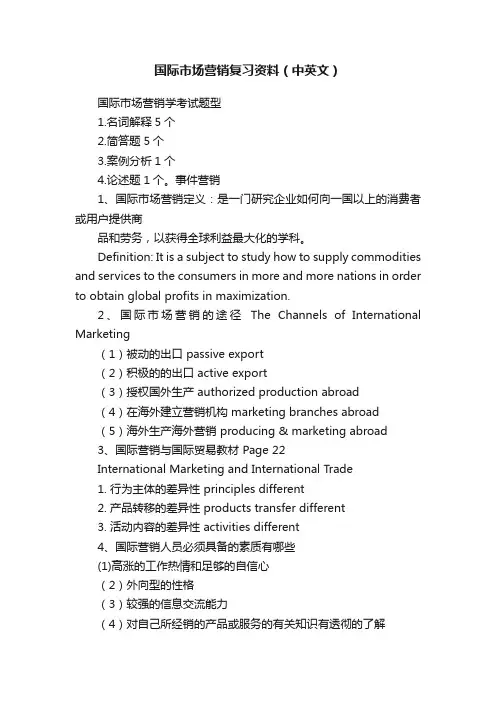
国际市场营销复习资料(中英文)国际市场营销学考试题型1.名词解释5个2.简答题5个3.案例分析1个4.论述题1个。
事件营销1、国际市场营销定义:是一门研究企业如何向一国以上的消费者或用户提供商品和劳务,以获得全球利益最大化的学科。
Definition: It is a subject to study how to supply commodities and services to the consumers in more and more nations in order to obtain global profits in maximization.2、国际市场营销的途径The Channels of International Marketing(1)被动的出口 passive export(2)积极的的出口 active export(3)授权国外生产 authorized production abroad(4)在海外建立营销机构 marketing branches abroad(5)海外生产海外营销 producing & marketing abroad3、国际营销与国际贸易教材 Page 22International Marketing and International Trade1. 行为主体的差异性 principles different2. 产品转移的差异性 products transfer different3. 活动内容的差异性 activities different4、国际营销人员必须具备的素质有哪些(1)高涨的工作热情和足够的自信心(2)外向型的性格(3)较强的信息交流能力(4)对自己所经销的产品或服务的有关知识有透彻的了解(5)高层次的社会工作能力(6)自我约束力和自我激发力(7)乐于为顾客服务,因为市场营销工作常常是在别人监督的情况下进行的,而且有些工作也是监督的(8)精力充沛,具体体力和脑力上的耐久力(9)能够注意服务潜在顾客的需要、愿望和和需求(10)精通或熟悉一门以上的外国语言,这是从事国际市场营销活动必不可少的工具(11)善于计划和实施销售任务,尤其要善于安排时间(12)对国际政治经济环境形势十分关注5、国际市场营销的环境人口环境、经济环境、自然环境、政治环境、法律环境、文化环境6、一个国家经济结构有哪几种形式?How many forms are the re in a nation’s economic structure?(1)原始农业经济 simple agriculture economy(2)原料输出经济 raw material-output economy(3)工业化进程中经济 industrializing economy(4)工业化经济 industrialized economyQuestion:1. 日本的自然环境因素怎样?How is the natural environment of Japan?日本是一个四面环海,境内多山,处于地震带的一个岛国。
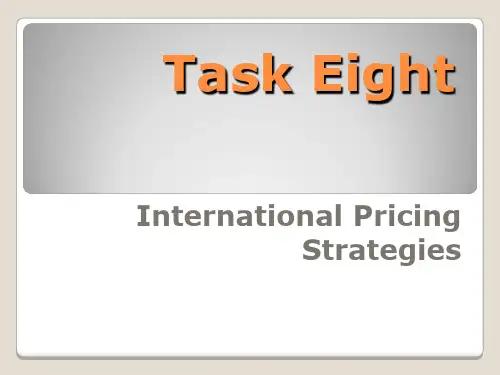
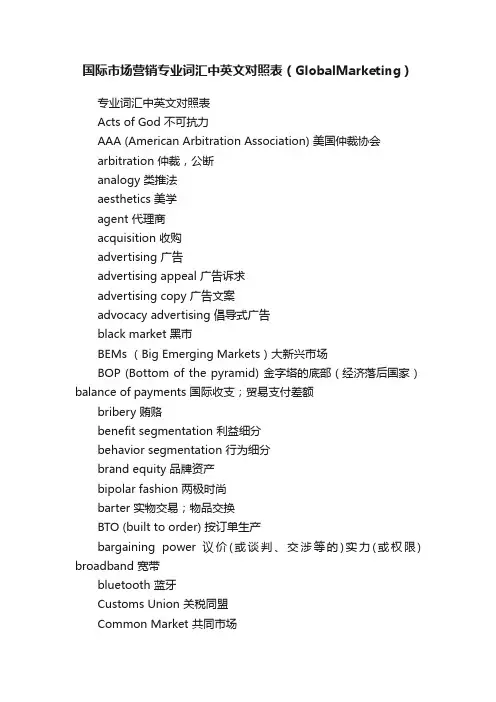
国际市场营销专业词汇中英文对照表(GlobalMarketing)专业词汇中英文对照表Acts of God 不可抗力AAA (American Arbitration Association) 美国仲裁协会arbitration 仲裁,公断analogy 类推法aesthetics 美学agent 代理商acquisition 收购advertising 广告advertising appeal 广告诉求advertising copy 广告文案advocacy advertising 倡导式广告black market 黑市BEMs (Big Emerging Markets)大新兴市场BOP (Bottom of the pyramid) 金字塔的底部(经济落后国家)balance of payments 国际收支;贸易支付差额bribery 贿赂benefit segmentation 利益细分behavior segmentation 行为细分brand equity 品牌资产bipolar fashion 两极时尚barter 实物交易;物品交换BTO (built to order) 按订单生产bargaining power 议价(或谈判、交涉等的)实力(或权限) broadband 宽带bluetooth 蓝牙Customs Union 关税同盟Common Market 共同市场collectivist culture 集体主义文化cultural typology 文化类型说common law (case law)普通法(案例法)civil law 成文法copyright 版权counterfeiting 伪造conflict resolution 冲突解决cluster analysis 集群分析;聚分析consumer panel 消费者反应研究小组cobranding 联合品牌cencentrated global marketing 集中全球营销cost-based pricing 成本加成定价CIF (cost,insurance,freight) 成本加保险费和运费CFR (cost and freight) 成本加运费cost-based transfer pricing 基于成本的转移价格competitive pricing 竞争性定价countertrade 对等贸易;反购贸易counterpurchase 互购;反向购买compensation trading 补偿贸易convenience store 便利店category killer “品类杀手”-掌握特定系列商品的优惠专卖店containerization 货柜运输,货柜装货corporate advertising 企业广告creative execution 创意执行collaborating 协作convergence 聚焦;集中channel 渠道competitive advantage 竞争性优势cross-border 跨国界的;跨境的centrally planned socialism 计划配置体制centrally planned capitalism 计划市场体制capital flow 资本流动;资金流current account 经常帐户capital account 固定资产帐户;资本性帐户call option 购买选择权distribution 渠道、分销domestic market 国内市场domestic company 国内型公司deficit 赤字depreciate 贬值;折旧devaluation (货币)贬值diffusion of innovation 创新扩散dispute settlement 争议调停demographic segmentation 人口统计细分diversification 多样化dynamical 有力量的differentiated global marketing 差异全球营销delivered duty paid 完税后交货(制定目的地)dumping 倾销distributor 分销商department store 百货公司discount store 廉价商店ethnocentric 母国中心的extension approach 延伸方式experience transfers 经验移植EU (European Union) 欧盟economic system 经济体制economic freedom index 经济自由度排名economic exposure 经济风险economic union 经济联盟environmental sensitivity 环境敏感性EDI (Electronic Data Interchange) 电子数据交换,无纸贸易ethnic segmentation 种族细分equity stake 股权ex-works 工厂内交货emotional appeal 感性诉求Foreign Exchange market 外汇市场forward market 期货市场FTA (Free Trade Area) 自由贸易区Femininity 女性气质FCPA (Foreign Corrupt Parctices Act) 国外腐败行为法FCCP (Foreign consumer culture positioning) 外国消费者文化定位franchising 特许经营FAS (free alongside ship) 装运港船边交货FOB (free on board) 船上交货fluctuation 不稳定性form utility 形态效用flagship model 旗舰模式global marketing 全球营销globalization 全球化GMS (Global Marketing Strategy) 全球营销策略global or transnational company 全球或跨国公司geocentric 世界中心的GATT (General Agreement on Tariffs and Trade) 关税与贸易总协定global strategy 全球战略GDP (Gross Domestic Product) 国内生产总值GNP (Gross National Product) 国民生产总值G-7 (Group of Seven) 七国集团global market segmentation 全球市场细分global teen 全球青少年细分市场global elite 全球精英阶层细分市场GCCP (global consumer culture positioning) 全球消费者文化定位greenfield investment 绿地投资government controls,subsidies 政府控制和补贴grey market 灰色市场global retailing 全球零售业hyperinflation 恶性通货膨胀high-context culture 高背景文化high touch product 高感性产品hypermarket 大卖场international company 国际型公司individualist culture 个人主义文化International Law Commission 国际法律委员会ICJ (International Court of Justice) 国际法庭(海牙)international convention 国际约定international custom 国际惯例Islamic law 伊斯兰法律intellectual property 知识产权ICC (International Chamber of Commerce) 国际商会ICCA (International Council for Commercial国际商业仲裁理事会Arbitration)incipient market 初始市场incoterms 国际贸易术语解释通则inflationary 通货膨胀的intangible property 无形资产information utility 信息效用inventory management 存货管理intermodal transportation 协调联运IMC (Integrated Marketing Communication) 整合营销传播idiom 方言,土语image advertising 形象广告jurisdiction 权限joint venture 合资localized or adaptation approach 本地化或适应化方式Leverage 杠杆作用low-income countries 低收入国家LDCs (Least-developed countries) 中低收入国家LAFTA (Latin America Free Trade Area) 拉美自由贸易区low-context culture 低背景文化LTO (long-term orientation) 长期取向license 许可licensor 许可证颁发者licensee 许可证接受者litigation 诉讼latent market 潜在市场LCCP (local consumer culture positioning) 当地消费者文化定位labeling 标签logistic 物流management orientations 管理取向multinational company 跨国公司management myopia 管理短视market capitalism 市场配置体制market socialism 市场社会主义体制monetary policy 货币政策MFA (Multifiber Arrangement) 多种纤维协定merchandise trade 商品贸易masculinity 男性气质MIS (Management Information System) 管理信息系统marketing model driver 营销模式驱动因素market skimming pricing strategy 市场撇脂定价策略market holding 市场保持marginal-cost pricing 边际成本定价market-based transfer price 基于市场的转移价格nonmonetary cost 非货币费用NAFTA (North American Free Trade Area) 北美自由贸易区national controls 国家管制NTBs (Non-tariffs barriers) 非关税壁垒NIEs (newly industrializing economies) 正在工业化的经济nationalization 国有化negotiated transfer price 协议转移价格organizational culture 组织文化orthodox 传统的OECD (Organization for Economic Cooperation and经济合作与发展组织Development)option 优先选择权ownership 所有权offset 抵销outlet store 处理品零售店(名品折扣店)organic growth 有机增长polycentric 东道国中心的postindustrial countries 后工业化国家product saturation levels 产品饱和度power distance 权利距离persistance 坚持,继续perseverance 坚定不移Permanent Court of International Justice 国际常设法庭Public international law 公共国际法Private international law 私人国际法patent 专利primary data 原始资料;第一手数据psychographic segmentation 心理因素细分positioning 定位product warranty 产品质量保证书platform 平台penetration pricing policy strategy 渗透性定价price escalation 价格升级price transparency 价格透明度parallel importing 平行进口puleria 杂货店place utility 地点效用PR (public relationships) 公共关系publicity 公众度product differentiation 产品差异化R&D-Research and Development 研究开发rival 竞争者regiocentric 区域中心的regional economic agreement 区域经济协定resource utilization 资源利用restraining forces 限制因素right of priority 优先权rational appeal 理性诉求rivalry 竞争;敌对状态standardized approach 标准化方式scale economic 规模经济services trade 服务贸易STO (short-term orientation) 短期取向SRC (self-reference criterion) 自参照标准surveillance 监督,监视secondary data 次级材料;第二手数据survey research 问卷调查standardized global marketing 标准化全球营销sourced goods 货源货物syndrome 综合病症switch trading 转口贸易;转手贸易specialty retailer 专业零售商specialty store 特种商店supermarket 超级市场supercenter 特大购物中心selling proposition 销售主张slang 俚语substitute product 替代产品strategic intent 战略意图spreadsheet 电子数据表,电子制表软件tariff protection 关税保护trade deficit 贸易逆差;贸易负差额trade surplus 贸易顺差;贸易盈余transaction exposure 交易风险thrift 节约,节俭Triad regions 三元区域trademark 商标trade secret 商业秘密target market 目标市场transfer pricing 转移价格tangible property 有形资产time utility 时间效用upper-middle-income countries 中高收入国家uncertainty avoidance 不确定性回避United Nations Charter 联合国宪章UCC (Uniform Commercial Code) 统一商业编码法usage rate 使用度user status 使用者身份value chain 价值链VALS (Value and Lifestyles) 价值观和生活方式市场细分系统WTO-World Trade Organization 世界贸易组织WIPO (World Intellectual Property Organization) 世界知识产权组织warehousing 仓储wireless connectivity 无线连接。
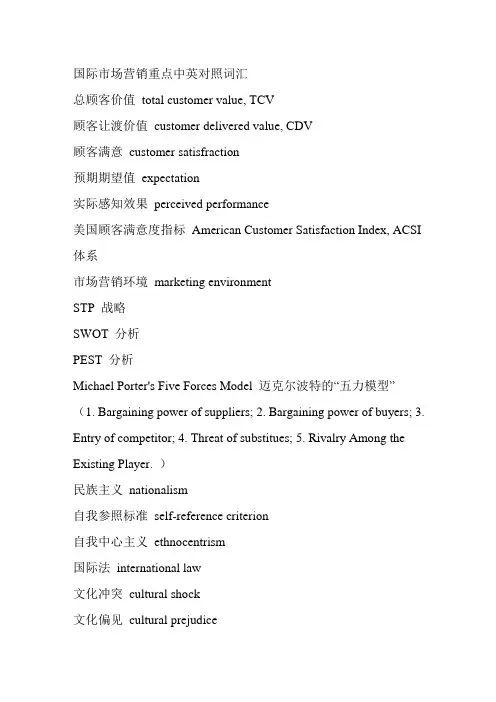
国际市场营销重点中英对照词汇总顾客价值total customer value, TCV顾客让渡价值customer delivered value, CDV顾客满意customer satisfraction预期期望值expectation实际感知效果perceived performance美国顾客满意度指标American Customer Satisfaction Index, ACSI 体系市场营销环境marketing environmentSTP 战略SWOT 分析PEST 分析Michael Porter's Five Forces Model 迈克尔波特的“五力模型”(1. Bargaining power of suppliers; 2. Bargaining power of buyers; 3. Entry of competitor; 4. Threat of substitues; 5. Rivalry Among the Existing Player. )民族主义nationalism自我参照标准self-reference criterion自我中心主义ethnocentrism国际法international law文化冲突cultural shock文化偏见cultural prejudice基督教Christianity伊斯兰教Islam印度教Hinduism佛教Buddhism北美自由贸易协定NAFTA东南亚国家联盟(东盟)ASEAN亚太经合组织APEC石油输出国组织OPEC国际货币基金组织IMF世界贸易组织WTO国际贸易法规委员会UNCTRAL国际标准化组织ISO英美法系British System大陆法系Civil Law System国民总收入/国民生产总值GNP (Gross National Product)国内总收入GDP (Gross Domestic Product)人均收入per captial income恩格尔系数(E)Engel's cofficient出口进入Exporting (indirect ~; direct ~)合同进入Contractual Agreement投资进入Investment \FDI ( joint venture合资企业, wholly-owned subsidiary独资企业)许可证贸易Licensing特许经营Franchising工程承包Turkey Entry\ operations合同制造Contract Manufacturing管理合同Management Contracting产品生命周期PLC产品项目item产品线product line产品组合product mix (宽度width; 深度depth; 长度length;相关性consistency)波士顿矩阵BCG Matrix\Box (Boston Consulting Group)明星产品Stars金牛产品Cash Cow问题产品Question Marks/Problem Children瘦狗产品DogsGE 分析(美国通用电气组合动态分析法General Electric Company)品牌名称brand name品牌标志brand mark品牌含义(attributes 属性;benefits 利益;value 价值;culture 文化;personality 个性;user 使用者)OBM(Own Brand Manufacturer)制造商自有品牌OB (Dealer Brand) 中间商品牌OEM (Original Equipment Manufacturer) 特许品牌策略/原始设备制造商/原产地委托加工/贴牌生产ODM (Original Design Manufacturer) 原始设计商固定成本fixed cost变动成本variable cost平均成本average cost边际成本marginal cost机会成本opportunity cost总成本total cost边际收入marginal revenue边际利润marginal profit边际效应marginal utility需求价格弹性price elasticity of demand成本加成定价法cost-plus pricing目标利润定价法target profit pricing边际成本定价法marginal-cost pricing需求导向定价法demand-oriented pricing竞争导向定价法competition-oriented pricing统一定价策略Extension Pricing Strategy多元定价策略Adaptation Pricing Strategy协调定价策略Invention Pricing Strategy撇脂定价策略Skimming Pricing Strategy渗透定价策略Penetration Pricing Strategy满意价格策略(折中/温和/君子价格)Satisfaction Pricing Strategy 倾销Dumping平行进口Parallel Import目标转移定价International Transfer Pricing Strategy渠道中间商middleman进口/出口中间商import/export intermediary批发商wholesaler零售商retailer零级/一级/二级/多级渠道zero/one/two/multi-level channel渠道决策“6Cs”: (费用cost; 资金capital; 控制control; 市场区域coverage; 特征character; 连续性continuity)标准化分销渠道standard distribution channel差异化分销渠道adapted distribution channel密集分销intensive distribution选择分销selecitve distribution独家分销exclusive distribution促销组合Promotion Mix (advertising 广告;personal selling 人员推销;sales promotion 营业推广;public relations 公共关系)国际营业推广international sales promotion (针对消费者的销售推广consumer promotion; 针对中间商的营业推广intertrade promotion; 针对销售人员的营业推广salesforce promotion)标准化广告策略Standadization Advertising Strategy差异化广告策略Adaptation Advertising Strategy模式化广告策略Pattern Advertising StrategyPOP 广告Point of Purchasing Advertising社会媒体Social Media内容营销Content Marketing直复营销Direct Marketing ( 直销direct selling;直邮营销Mail Selling; 电话营销Telemarketing; 电视营销Cable Selling; 网络营销Online Marketing)。
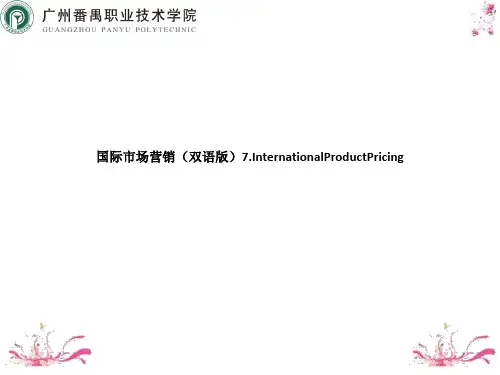
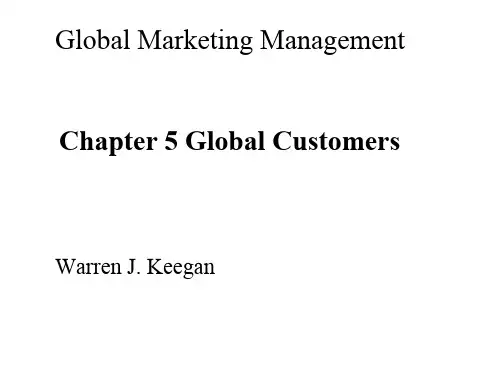
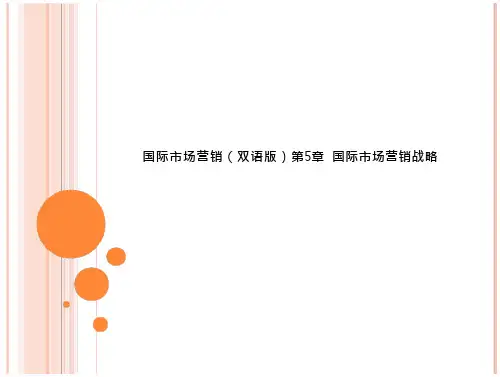

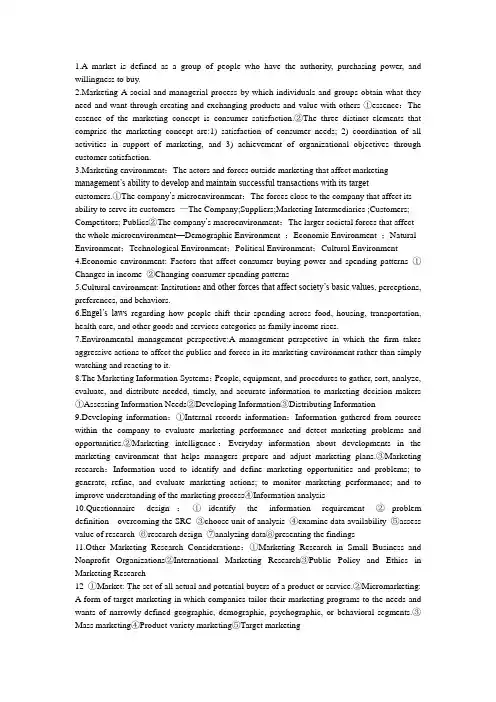
1.A market is defined as a group of people who have the authority, purchasing power, and willingness to buy.2.Marketing A social and managerial process by which individuals and groups obtain what they need and want through creating and exchanging products and value with others ①essence:The essence of the marketing concept is consumer satisfaction.②The three distinct elements that comprise the marketing concept are:1) satisfaction of consumer needs; 2) coordination of all activities in support of marketing, and 3) achievement of organizational objectives through customer satisfaction.3.Marketing environment:The actors and forces outside marketing that affect marketing management’s ability to develop and maintain successful transactions with its target customers.①The company’s microenvironment:The forces close to the company that affect its ability to serve its customers —The Company;Suppliers;Marketing Intermediaries ;Customers; Competitors; Publics②The company’s macroenvironment:The larger societal forces that affect the whole microenvironment—Demographic Environment ;Economic Environment ;Natural Environment;Technological Environment;Political Environment;Cultural Environment4.Economic environment: Factors that affect consumer buying power and spending patterns ①Changes in income ②Changing consumer spending patterns5.Cultural environment: Institutions and other forces that affect society’s basic values, perceptions, preferences, and behaviors.6.Engel’s laws regarding how people shift their spending across food, housing, transportation, health care, and other goods and services categories as family income rises.7.Environmental management perspective:A management perspective in which the firm takes aggressive actions to affect the publics and forces in its marketing environment rather than simply watching and reacting to it.8.The Marketing Information Systems:People, equipment, and procedures to gather, sort, analyze, evaluate, and distribute needed, timely, and accurate information to marketing decision makers①Assessing Information Needs②Developing Information③Distributing Information9.Developing information:①Internal records information:Information gathered from sources within the company to evaluate marketing performance and detect marketing problems and opportunities.②Marketing intelligence:Everyday information about developments in the marketing environment that helps managers prepare and adjust marketing plans.③Marketing research:Information used to identify and define marketing opportunities and problems; to generate, refine, and evaluate marketing actions; to monitor marketing performance; and to improve understanding of the marketing process④Information analysis10.Questionnaire design:①identify the information requirement ②problem definition---overcoming the SRC ③choose unit of analysis ④examine data availability ⑤assess value of research ⑥research design ⑦analyzing data⑧presenting the findings11.Other Marketing Research Considerations:①Marketing Research in Small Business and Nonprofit Organizations②International Marketing Research③Public Policy and Ethics in Marketing Research12 ①Market: The set of all actual and potential buyers of a product or service.②Micromarketing:A form of target marketing in which companies tailor their marketing programs to the needs and wants of narrowly defined geographic, demographic, psychographic, or behavioral segments.③Mass marketing④Product-variety marketing⑤Target marketing13.Market segmentation: represents an effort to identify and categorize groups of customers and countries according to common characteristics14.Market targeting: The process of evaluating each market segment’s attractiveness and selecting one or more segments to enter.15.Market positioning: Formulating competitive positioning for a product and creating a detailed marketing mix.16.The bases for segmenting consumer ①Geographic segmentation:Dividing a market into different geographical units such as nations, states, regions, counties, cities, or neighborhoods.②Demographic segmentation:Dividing the market into groups based on demographic variables such as age, sex, family size, family life cycle, income③Psychographic segmentation Dividing a market into different groups based on social class, lifestyle, or personality characteristics.④Behavioral segmentation:Dividing a market into groups based on consumer knowledge, attitude, use, or responses to a product.⑤Targeting multiple segments17.Segmenting business market:①Programmed buyers②Relationship buyers③Transaction buyers④Bargain hunters18.Inter market segmentation:Forming segments of consumers who have similar needs and buying behavior even though they are located in different countries.19.Target Market: A set of buyers sharing common needs or characteristics that the company decides to serve.20.Undifferentiated marketing: A market-coverage strategy in which a firm decides to ignore market segment differences and go after the whole market with one offer.21.Differentiated marketing: A market-coverage strategy in which a firm decides to target several market segments and designs separate offers for each.22.Concentrated marketing: A market-coverage strategy in which a firm goes after a large share of one or a few submarkets27.Product position:The way that the product is defined by consumers on important attributes-the place that the product occupies in consumers’ minds relative to competing products.22.Positioning for competitive advantage:Competitive advantage: An advantage over competitors gained by offering consumers greater value, either through lower prices or by providing more benefits that justify higher prices.①Positioning Strategies ②Choosing and Implementing a Positioning Strategy23.Choosing implementing a position strategy:①Identifying possible competitive advantages:1)Product differentiation2)Services differentiation3)Personnel differentiation4)Image differentiation ②Selecting the right competitive advantages:important distinctive superior communicable preemptive affordable profitable ③Communicating and delivering the chosen position24.Product:Anything that can be offered to a market for attention, acquisition, use, or consumption that might satisfy a want or need.25.①Brand: A name, term, sign, or design, or a combination of these, intended to identify the goods or services of one seller or group of sellers and to differentiate them from those of competitors.②Brand name: That part of a brand that can be vocalized-the . Examples are Avon, Chevrolet, Disneyland, American Express, and UCLA.③Trademark: A brand or part of a brand that is given legal protection-it protects the seller’s exclusive rights to use the brand name or brand mark.④Copyright: The exclusive legal right to reproduce, publish, and sell the matter and form ofa literary, musical, or artistic work.26.Product attributes:①Product quality:The ability of a product to perform its functions; it includes the product’s overall durability, reliability, precision, ease of operation and repair, and other valued attributes.②Product features③Product design27.Packaging:is the activities of designing and producing the container or wrapper for a product.28.Price: The amount of money charged for a product or service, or the sum of the values that consumers exchange for the benefits of having or using the product or service.29Advertising: defined as any sponsored,paid message that is communicated in a nonpersonal way.①Setting objectives②Setting the advertising budget③Advertising strategy④Advertising evaluation⑤Organizing for advertising⑥International advertising decisions30.Advertising strategy:①Creating the advertising message②Selecting advertising media31.Advertising agency:A marketing service organization that assists other companies in the planning, creation, and implementation of their advertising programs.32.Sales promotion: Short-term incentives to encourage purchase or sales of a product or service.①Rapid Growth of Sales Promotion②Setting Sales-Promotion Objectives③Selecting Sales-Promotion Tools④Developing the Sales-Promotion Program33Discount: A straight reduction in price on purchases during a stated period of time.34.Allowance: Promotional money paid by manufacturers to retailers who agree to feature the manufacturer’s products in some way.。
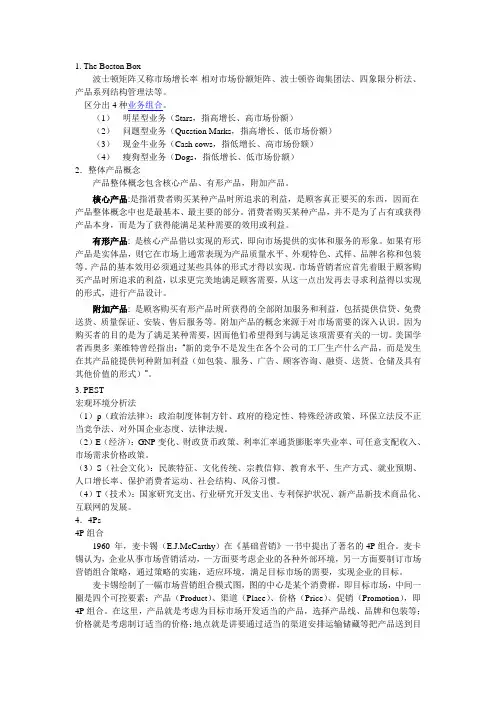
1. The Boston Box波士顿矩阵又称市场增长率-相对市场份额矩阵、波士顿咨询集团法、四象限分析法、产品系列结构管理法等。
区分出4种业务组合。
(1)明星型业务(Stars,指高增长、高市场份额)(2)问题型业务(Question Marks,指高增长、低市场份额)(3)现金牛业务(Cash cows,指低增长、高市场份额)(4)瘦狗型业务(Dogs,指低增长、低市场份额)2.整体产品概念产品整体概念包含核心产品、有形产品,附加产品。
核心产品:是指消费者购买某种产品时所追求的利益,是顾客真正要买的东西,因而在产品整体概念中也是最基本、最主要的部分。
消费者购买某种产品,并不是为了占有或获得产品本身,而是为了获得能满足某种需要的效用或利益。
有形产品: 是核心产品借以实现的形式,即向市场提供的实体和服务的形象。
如果有形产品是实体品,则它在市场上通常表现为产品质量水平、外观特色、式样、品牌名称和包装等。
产品的基本效用必须通过某些具体的形式才得以实现。
市场营销者应首先着眼于顾客购买产品时所追求的利益,以求更完美地满足顾客需要,从这一点出发再去寻求利益得以实现的形式,进行产品设计。
附加产品: 是顾客购买有形产品时所获得的全部附加服务和利益,包括提供信贷、免费送货、质量保证、安装、售后服务等。
附加产品的概念来源于对市场需要的深入认识。
因为购买者的目的是为了满足某种需要,因而他们希望得到与满足该项需要有关的一切。
美国学者西奥多·莱维特曾经指出:“新的竞争不是发生在各个公司的工厂生产什么产品,而是发生在其产品能提供何种附加利益(如包装、服务、广告、顾客咨询、融资、送货、仓储及具有其他价值的形式)”。
3. PEST宏观环境分析法(1)p(政治法律):政治制度体制方针、政府的稳定性、特殊经济政策、环保立法反不正当竞争法、对外国企业态度、法律法规。
(2)E(经济):GNP变化、财政货币政策、利率汇率通货膨胀率失业率、可任意支配收入、市场需求价格政策。
国际营销(双语)期末章节重点考试题型:单选10×1判断并改错5×3名词解释5×4简答5×6论述1×10案例分析1×15第一章The Scope and Challenge of International Marketing一、名词解释1、international marketing国际市场International marketing is the performance of business activities designed to plan,price,promote,and direct the flow of a company's goods and service to Consumer or users in more than one nation for a profit.2、uncontrollable elements不可控因素The elements of business environment which beyond the control of companies.3、SRC Self-Reference Criterion自我参展标准An unconscious reference to one's own cultural values, experiences,and knowledge as a basis for decision.4、Global Awareness全球意识Tolerance of cultural difference and knowledge of cultures, history,world marketpotential,and global economic, social,and political trends.二、简答2、“...the marketer’s task is the same whether appliedin Dime Box,Texas,or Dar es Salaam,Tanzania.”Discuss. The only difference between domestic marketing and international marketing is that the activities take place in more than one country.Therefore,the marketing task is the same throughout the world.As the business’s goal is same in different place,which is to make profit by promoting,pricing,and distributing products for which there is a market.In the other word,the task never change, which are deal with controllable elements and uncontrollable elements.4、Discuss the four phases of international marketing involvement.国际市场营销的四个阶段The first phase is domestic firms which have no foreign business activity except those sales made to foreign customers who come directly to the firm.The second is domestic firms which have temporary surpluses which are sold abroad on an availability basis with no intention for continuing market representation. The third is the domestic firms that have permanent productive capacity which is used toproduce goods which are sold on a continuing basis in foreign markets.The fourth is the international company that produces aproduct for the world market.5、Discuss the conditions that have led to the development of global markets.讨论导致全球市场发展的条件。
《国际市场营销学》复习资料一、填空题(1x18)1、把新产品引入新文化中的选择方案The introduction of the new product options for the international market2、新产品定价策略Pricing strategy of new products撇脂定价策略 skimming pricing strategy;渗透定价策略 penetration pricing strategy3、出口方进入国际市场典型的间接分销渠道Way to enter the international export market, the typical indirect distribution channels制造商出口中间商进口中间商经销商最终消费者4、重点集中战略的两种形式Two forms of focus strategy成本重点集中 cost focused;差异重点集中 focused differentation5、信息的两种来源Two sources of information二手资料secondary information(desk reseach)文案;原始资料primary information(field research)实地6、G-Hoftedes 的两种文化价值理论G-Hoftedes the two cultures theory of value权力距离指数 power distance(PDI)、个人主义 individualism(IDV)、不确定性规避指数 uncertainty avoidance(UAV)、价值观的男性度和女性度指数 masculinity(MAS)7、国际战略联盟的三种形式Three forms of international strategic alliance水平战略联盟、垂直战略联盟、混合联盟或跨行业联合大企业协议8、产品生命周期的四个阶段The four stages of product life cycle导入期 introduct、成长期 growth、成熟期 maturity、衰退期 decline.9、管理的四种导向Four-oriented management本国中心主义 Ethnocetrism 多中心主义 polycentrism地区中心主义 regioncentrism 全球中心主义 geocentrism10、产品的基本层次The basic level of productCore benefit 核心利益, actual product一般产品, expected product期望产品,augumented product 附加产品, potential product潜在产品11、菲利普·科特勒的三个层次Philip• Kotler of the three levelsCore product核心产品 ,tangible product有形产品 ,augment product 附加产品12、品牌包括哪几个部分Brands include several components13、企业进入国际市场的四种模式Enterprises to enter international markets four modes出口进入模式exporting entering、契约进入模式contract entering、投资进入模式investment entering 、互联网进入模式internet entering.14、国际市场营销的三种形态Three forms of international marketing跨越国界型或对外营销型international marketing、异国型或国外营销型 foreign marketing、多国型或多国营销 multinational marketing.15、国际市场的细分标准Standards of international market segmentation地理变数geographical segmentation、人口变数demographic segmentation、心理变数psychological segmentation、行为变数behavior segmentation.16、新贸易保护主义的三个方面Three aspects of the new trade protectionism绿色壁垒green barrier、技术壁垒technical barrier、反倾销和知识产权保护anti-dumping and intellectual property protection17、文化知识分为哪两类Cultural knowledge, which is divided into two categories事实性知识fact knowledge、解释性知识explanative knowledge18、迈克尔·波特的3种经营战略Michael Porter's three business strategy •总成本领先战略 overall cost leadership 差异化战略 differentiation重点集中战略 the narrow-focus advantage19、绿色营销的四个内容Four elements of Green Marketing绿色产品 green products 绿色分销green distribution绿色促销green promotion 绿色价格green price20、核心竞争力的特点The characteristics of core competencies不可模仿性、团队学习能力、具有专门的知识和独特的技术、主旨整合能力21、国际市场营销产品定位的两种形式International marketing product positioning of the two forms高技术定位 high technological positioning 高接触定位 high touch22、营销沟通战略的四部分Four-part marketing communications strategy23、目标管理的坏境因素Environmental management by objectives政治环境political environment、经济环境economic environment、社会文化环境social cultural environment、地理环境geographical environment24、国际目标市场选择应符合的标准Target market selection should be consistent with international standards可测量性measurability 、可进入性 accessibility 、需求足量性substantiality、易反应性 actionability25、产品因素对企业进入方式的影响主要表现在Product factors into the way of enterprises mainly in the1.产品要素密集度。
国际市场营销学培训讲义(英文版) International Marketing Training HandbookSession 1: Introduction to International Marketing1.1 Definition of International Marketing- Explanation of international marketing and its importance in today's globalized world.- Overview of key concepts, such as globalization, market segmentation, and cultural diversity.1.2 Benefits and Challenges of International Marketing- Discussion on the advantages of expanding into international markets, such as increased sales and new business opportunities. - Identification of common challenges, such as cultural differences, legal and regulatory complexities, and competitive pressures.1.3 International Marketing Strategies- Introduction to different strategies for entering international markets, including exporting, licensing, joint ventures, and direct investment.- Examination of factors influencing strategy selection, such as market potential, risk assessment, and resource allocation. Session 2: Market Research and Analysis2.1 Understanding Global Consumers- Analysis of cultural differences and their impact on consumer behavior.- Identification of global consumer segments and trends to targeteffectively.2.2 Market Research Methods- Overview of primary and secondary research methods for gathering market intelligence.- Explanation of techniques for analyzing market data, such as surveys, focus groups, and data mining.2.3 Assessing Market Potential- Examination of key factors to consider when evaluating market potential, including market size, growth rate, and competition.- Introduction to tools and frameworks for assessing market attractiveness and competitiveness.Session 3: Market Entry Strategies3.1 Exporting and Importing- Discussion on the advantages and disadvantages of exporting and importing.- Explanation of export and import processes, including logistics, documentation, and international trade regulations.3.2 Licensing and Franchising- Overview of licensing and franchising as market entry strategies. - Examination of the benefits, risks, and considerations involved in entering into licensing and franchising agreements.3.3 Joint Ventures and Strategic Alliances- Introduction to joint ventures and strategic alliances as collaborative market entry strategies.- Analysis of the advantages, challenges, and factors for successful partnerships.Session 4: Product and Brand Management4.1 Adaptation vs. Standardization- Examination of product and brand adaptation strategies to suit local market preferences.- Discussion on the benefits and risks of standardizing products and brands across international markets.4.2 Product Development and Innovation- Overview of product development processes for international markets.- Introduction to strategies for fostering innovation and staying competitive in global markets.4.3 Branding and Positioning- Explanation of brand building and positioning strategies for global brands.- Examination of the role of culture, communication, and customer perception in successful international branding.Session 5: Communication and Promotion5.1 Integrated Marketing Communications- Introduction to integrated marketing communications (IMC) and its role in international marketing.- Explanation of different promotional tools and channels, such as advertising, public relations, and digital marketing.5.2 Cultural Sensitivity in Communication- Discussion on the importance of cultural sensitivity and adaptation in international communication.- Analysis of successful cross-cultural marketing campaigns and the lessons learned.5.3 Digital Marketing in International Markets- Overview of digital marketing strategies and tactics for reaching global audiences.- Examination of the challenges and opportunities in leveraging digital platforms for international marketing.Note: This training handbook provides an overview of key topicsin international marketing and can be customized to suit specific training objectives and participant needs.Session 6: Pricing and Distribution6.1 Pricing Strategies in International Markets- Explanation of factors affecting pricing decisions in international markets, such as currency fluctuations, local market conditions, and competition.- Introduction to pricing strategies, such as cost-based pricing, market-based pricing, and value-based pricing.6.2 Distribution Channels and Logistics- Overview of distribution channel options in international markets, including direct sales, distributors, agents, and e-commerce.- Examination of logistics considerations, such as transportation, warehousing, and customs regulations.6.3 Channel Management and Relationship Building- Discussion on the importance of effective channel management and relationship building with international partners.- Introduction to strategies for selecting, managing, and incentivizing channel partners.Session 7: Legal and Ethical Considerations7.1 International Legal Framework- Overview of international trade laws and regulations, such as tariff and non-tariff barriers, intellectual property protection, and contract laws.- Explanation of the role of international organizations, such as the World Trade Organization (WTO), in promoting fair trade practices.7.2 Ethical Issues in International Marketing- Analysis of ethical dilemmas and challenges in international marketing, such as cultural sensitivity, advertising standards, and environmental sustainability.- Discussion on the importance of corporate social responsibility (CSR) in international business practices.7.3 Risk Management and Compliance- Introduction to risk management strategies for mitigating legal and ethical risks in international marketing.- Explanation of compliance standards, such as anti-corruption laws and data privacy regulations, that businesses need to adhere to in global markets.Session 8: Market Expansion and Growth8.1 Emerging Markets and Opportunities- Analysis of emerging markets and their potential for business expansion and growth.- Discussion on strategies for entering and succeeding in emerging markets, such as adaptation to local conditions and collaboration with local partners.8.2 International Business Development- Overview of strategies and considerations for expanding and growing international business operations.- Discussion on factors such as market diversification, innovation, and strategic partnerships.8.3 Sustainable International Marketing- Examination of sustainability and responsible business practices in international marketing.- Introduction to concepts such as green marketing, social entrepreneurship, and inclusive business models.Session 9: Cross-Cultural Communication and Negotiation9.1 The Importance of Cross-Cultural Communication- Explanation of the challenges and opportunities presented by cross-cultural communication in international business.- Analysis of cultural dimensions and their impact on communication styles and business practices.9.2 Cross-Cultural Negotiation- Overview of negotiation strategies and techniques in cross-cultural settings.- Examination of cultural norms and practices that influence negotiation processes and outcomes.9.3 Managing Cultural Differences- Discussion on strategies for managing and leveraging cultural differences in international business.- Introduction to intercultural competence skills, such as empathy, adaptability, and cultural intelligence.Session 10: International Marketing Plan10.1 Developing an International Marketing Plan- Step-by-step guide to developing an international marketing plan. - Explanation of key components, such as market analysis, target market selection, marketing objectives, and implementation strategies.10.2 Evaluating and Monitoring International Marketing Performance- Introduction to metrics and tools for evaluating the performance of international marketing activities.- Discussion on the importance of monitoring and adjusting strategies based on market feedback and changing conditions. 10.3 Case Studies and Best Practices in International Marketing- Analysis of real-world case studies and best practices in international marketing.- Examination of successful international marketing campaigns and their underlying strategies and tactics.Note: This training handbook provides an overview of key topics in international marketing and can be customized to suit specific training objectives and participant needs. The content can be expanded upon by incorporating additional case studies, interactive exercises, and group discussions to enhance participant engagement and learning.。
一、填空题1、企业跨国营销发展五个阶段?the five stages of International MarketingDevelopment?国内营销(domestic marketing)、出口营销(exporting marketing)、国际营销(international marketing)、多国营销(multinational markrting)、全球营销(global marketing)2、企业哪几种形式进入外国市场?What kinds of forms to enter foreignmarkets?出口进入模式、投资进入模式、契约进入模式、互联网进入模式3、经营哲学演变五个阶段?the five stages of the evolution of managementphilosophy?以生产为导向的传统营销观念(traditional marketing concept)以国外顾客为导向的营销新观念(new marketing concept)以外部环境为导向的营销战略观念(stategic marketing concept)以全球市场为导向的全球营销观念(global marketing concept)4、中间商按是否拥有所有权可分为哪两种?whether by ownership ofintermediaries which can be divided into two?经销中间商、代理中间商5、产品整体观念五个层次?the five levels of product?核心产品(core product)、一般产品(actual product)、期望产品(expected product)、附加产品(augmented product)、潜在产品(potential product)6、战略联盟分为哪三种类型?which is divided into three types of strategicalliances?水平战略联盟、垂直战略联盟、混合战略联盟7、波特提出哪三种竞争战略?Porter proposed three types of competitivestrategies ?总成本领先战略(overall cost leadership)差异化战略(differentiation)重点集中战略(the narrow focus advantage)8、出口方式进入国际市场,典型的间接分销渠道?371制造商—出口中间商—进口中间商—经销商—最终消费者9、定价的方法?pricing methods/techniques成本导向定价法(cost-based pricing)需求导向定价法(demand-based pricing)竞争导向定价法(competition-based pricing)10、重点竞争战略的概念?the concept of key competitive strategy ?重点集中战略是指企业或事业部将经营重点集中在市场或产品的某一部分。
国际市场营销学考试题型1.名词解释5个2.简答题5个3.案例分析1个4.论述题1个。
事件营销1、国际市场营销定义:是一门研究企业如何向一国以上的消费者或用户提供商品和劳务,以获得全球利益最大化的学科。
Definition: It is a subject to study how to supply commodities and services to the consumers in more and more nations in order to obtain global profits in maximization.2、国际市场营销的途径 The Channels of International Marketing(1)被动的出口 passive export(2)积极的的出口 active export(3)授权国外生产 authorized production abroad(4)在海外建立营销机构 marketing branches abroad(5)海外生产海外营销 producing & marketing abroad3、国际营销与国际贸易教材 Page 22International Marketing and International Trade1. 行为主体的差异性 principles different2. 产品转移的差异性 products transfer different3. 活动内容的差异性 activities different4、国际营销人员必须具备的素质有哪些(1)高涨的工作热情和足够的自信心(2)外向型的性格(3)较强的信息交流能力(4)对自己所经销的产品或服务的有关知识有透彻的了解(5)高层次的社会工作能力(6)自我约束力和自我激发力(7)乐于为顾客服务,因为市场营销工作常常是在别人监督的情况下进行的,而且有些工作也是监督的(8)精力充沛,具体体力和脑力上的耐久力(9)能够注意服务潜在顾客的需要、愿望和和需求(10)精通或熟悉一门以上的外国语言,这是从事国际市场营销活动必不可少的工具(11)善于计划和实施销售任务,尤其要善于安排时间(12)对国际政治经济环境形势十分关注5、国际市场营销的环境人口环境、经济环境、自然环境、政治环境、法律环境、文化环境6、一个国家经济结构有哪几种形式?How many forms are the re in a nation’s economic structure?(1)原始农业经济 simple agriculture economy(2)原料输出经济 raw material-output economy(3)工业化进程中经济 industrializing economy(4)工业化经济 industrialized economyQuestion:1. 日本的自然环境因素怎样?How is the natural environment of Japan?日本是一个四面环海,境内多山,处于地震带的一个岛国。
多火山地震发生。
Japan is a country with sea around, and there are many mountains in the island. It is an island country in seismic zone and always has volcanic and earthquake.2. 根据日本的自然环境因素情况,哪些产品适合在日本营销?Which products are suitable for marketing in Japan according to its natural environment?鱼类加工产品、捕鱼工具、船、救生工具、防毒面具、板房等产品适合在日本营销。
Fish processing products, fishing tools, boats, life saving, gasmasks, houses ect can marketing in Japan.7、产品策略的意义一个国际营销企业能否在国际市场上生存和发展,取决于它的产品在国际市场上是否能符合消费者的需要。
所以不断更新和改进产品,以满足国际市场不断变化的需求,是营销工作不可缺少的重要环节。
Importance of product strategies:Whether an international enterprise can survive and develop in the international markets or not, it depends on the satisfaction level of consumers to the products and services from international markets . So updating and improving the products continuously to meet the changing demands of international markets is the first necessary step for international marketing.8、国际产品的整体概念Global Concept of International Product包含3个层次:核心产品、形式产品、附加产品。
Including 3 levels: core product,、formal product and appendix product. Page: 2019、国际产品标准化、差异化Standardization and variety of International Product产品标准化:用同一产品去满足不同国际市场的需要,便于大规模机械化生产,成本低。
Product standardization: by using one unified product to meet the demands from different international markets. It is convenient for large scale and mechanical production, and the cost is lower.产品差异化:用不同类型产品去满足不同国际市场的需要,更具针对性,但不便于大规模生产,成本高。
Product variety: by using different series of product to meet the demands from different international markets. It is with more pertinence, but inconvenient for large scale production, and the cost is higher.10、国际产品的调整与适应策略Adjustment and Adaptation Strategies forInternational Product(1)直接延伸 Direct Extension(2)适应策略 Adaptation Strategies11、国际市场产品生命周期Product’s Life Cycle in International Markets (1)定义:产品从投入市场到最终退出市场的全过程称为产品生命周期,该过程一般经历产品的导入期、成长期、成熟期和衰退期四个阶段。
Definition: The whole process of products from getting in the markets to getting out the markets. It includes four stages of leading-in, growing up, maturation and decline.(2)产品生命周期各阶段的营销策略Marketing Strategies in different stages of Product’s Life Cycle1. Marketing strategies in Leading-in Stages P211(2)Fast Skimming 快速撇脂策略(3)Slowly Skimming 缓慢撇脂策略(4)Fast Penetrating 快速渗透策略(5)Slowly Penetrating 缓慢渗透策略2. Marketing strategies in Growing up Stages P212(1)Improving Quality 改进产品质量(2)Enlarging Scale & lowering Price扩大规模降价(3)Establishing Brand 树立品牌形象3. Marketing strategies in Maturation Stages P213(1) Market Improving 市场改良(2) Product Improving 产品改良(3) Marketing Combination Improving营销组合改良4. Marketing strategies in Decline Stages P213(1) Maintaining 继续维持(2) Shrinking 收缩榨取(3) Abandoning 放弃撤离12、国际新产品开发策略意义Development Strategies for International NewProduct意义 SignificanceSince consumers’requirements from international markets are different and changing continuously, and also products have their lifecycles and finally out, we have to create and develop new products into the markets for our survivals & developments.14、国际品牌策略International Brand Strategies P222—225现实中常用品牌策略Often used brand strategies in reality for international marketing activities.(1)统一品牌:所有产品使用同一个品牌。